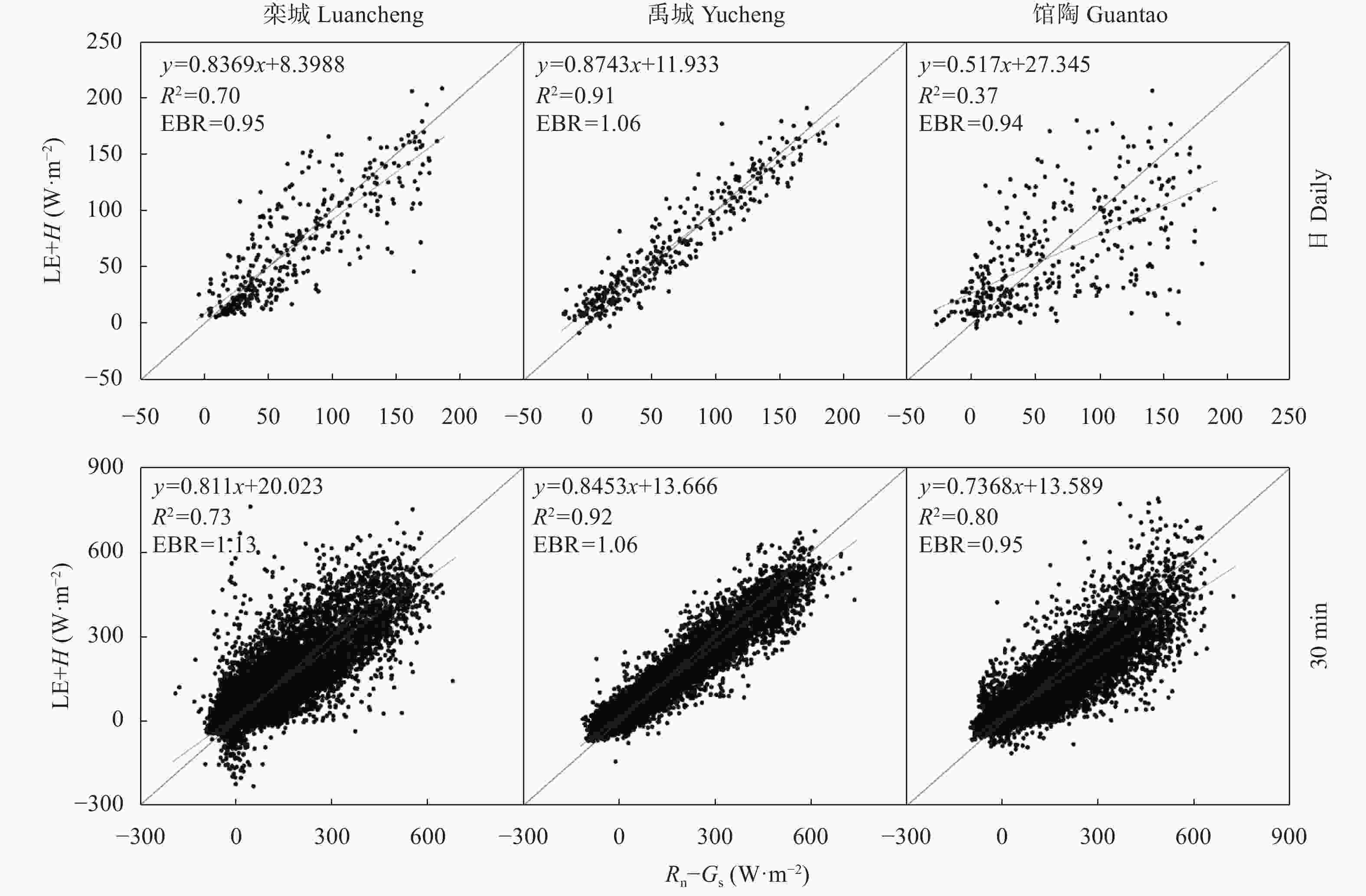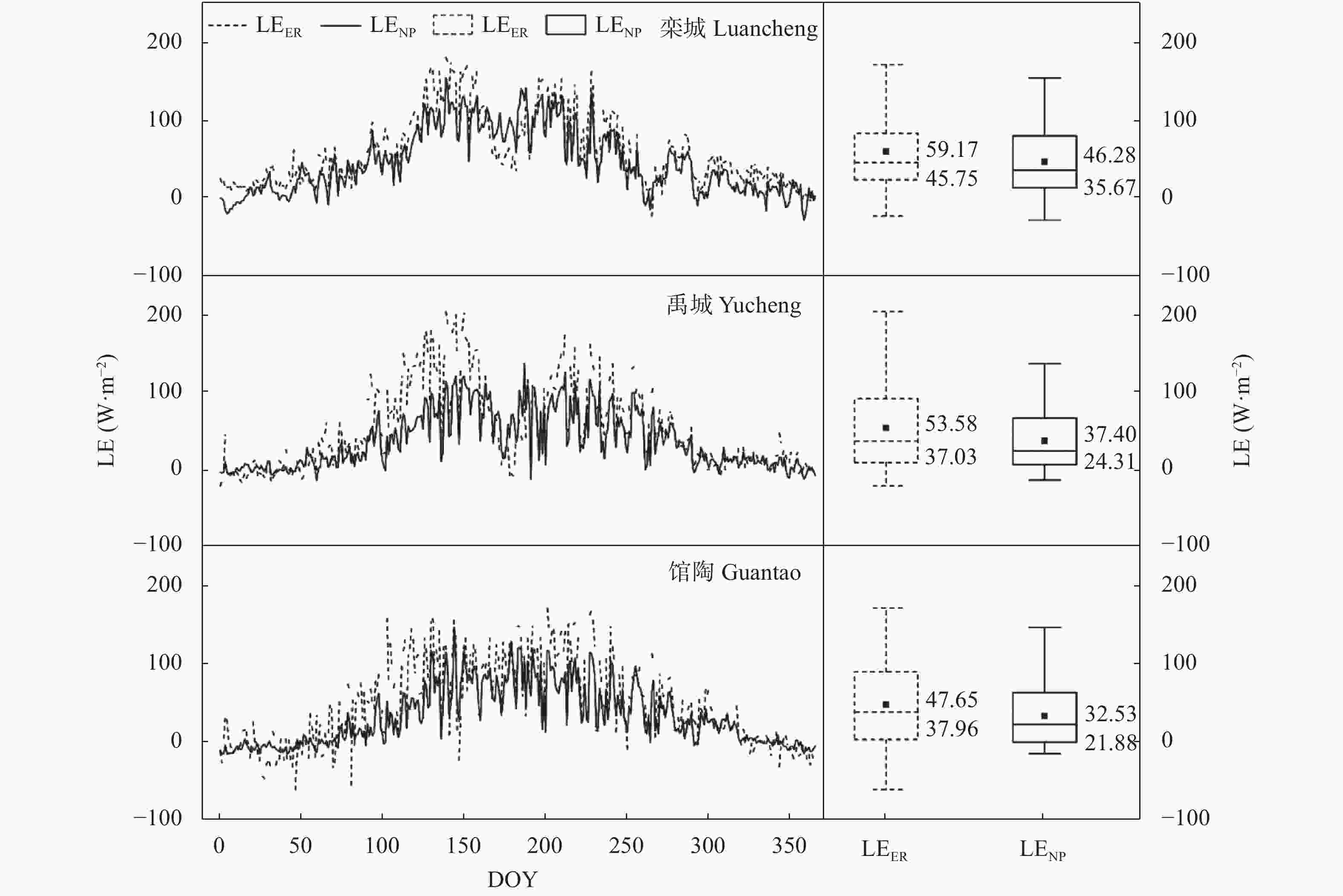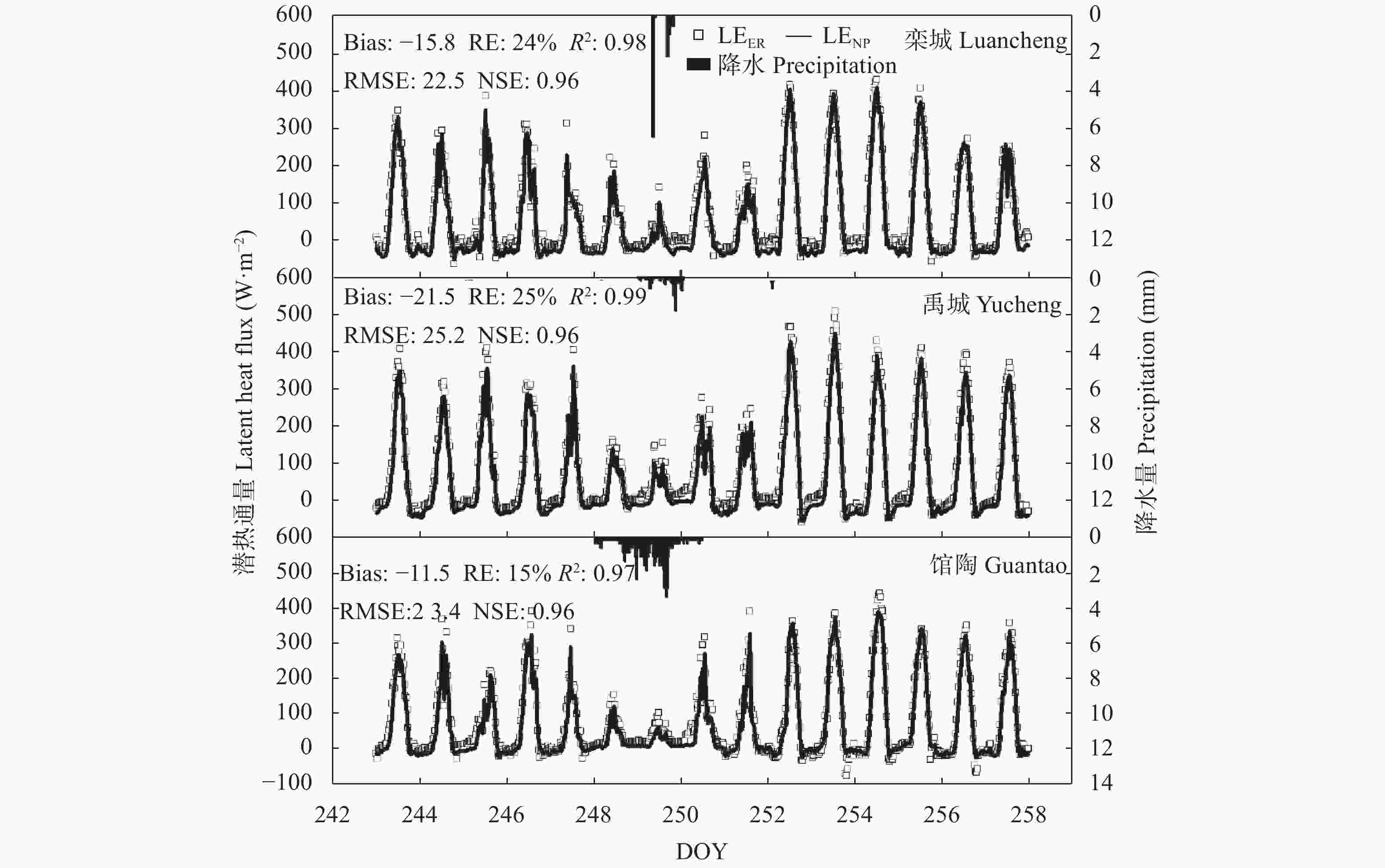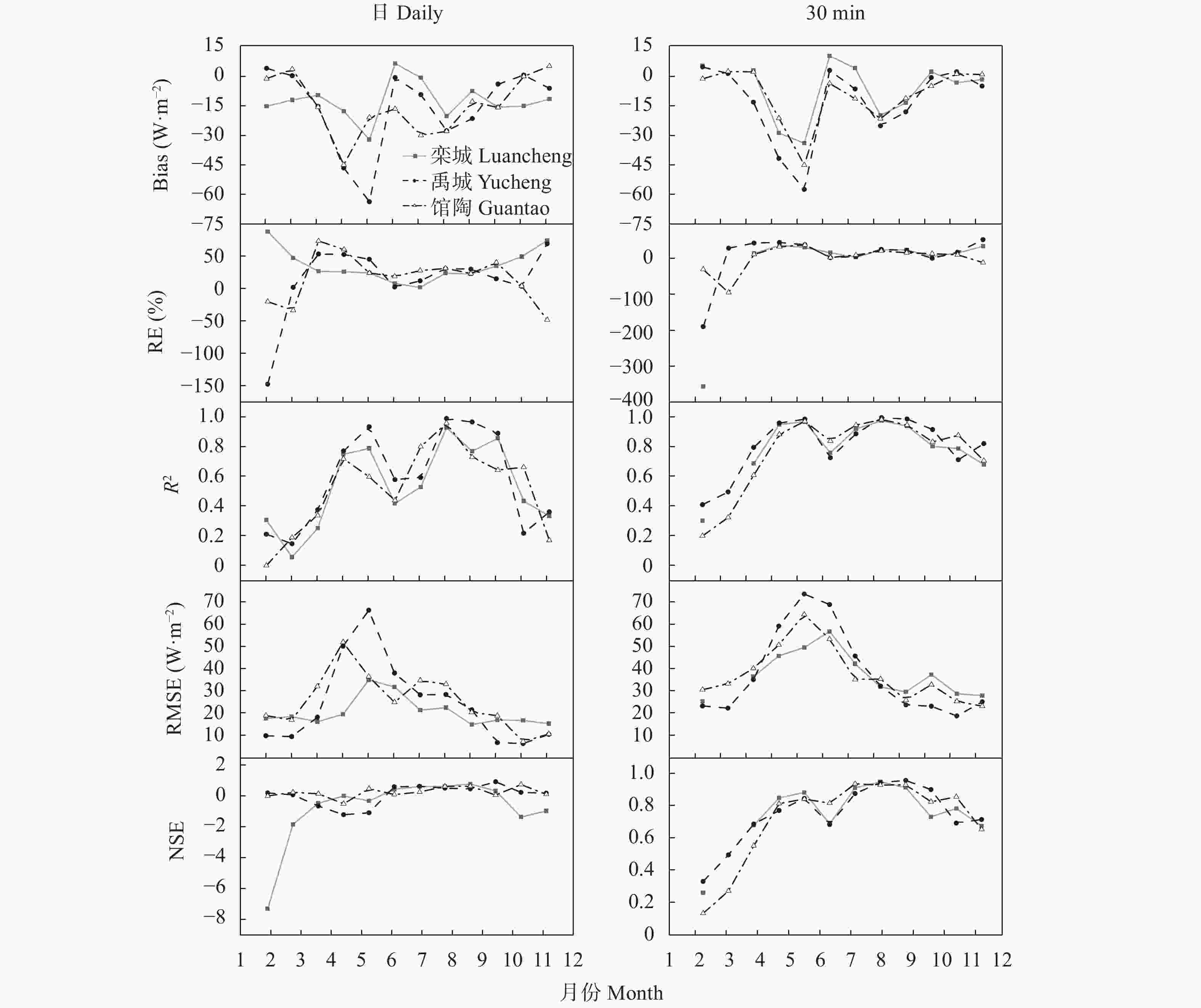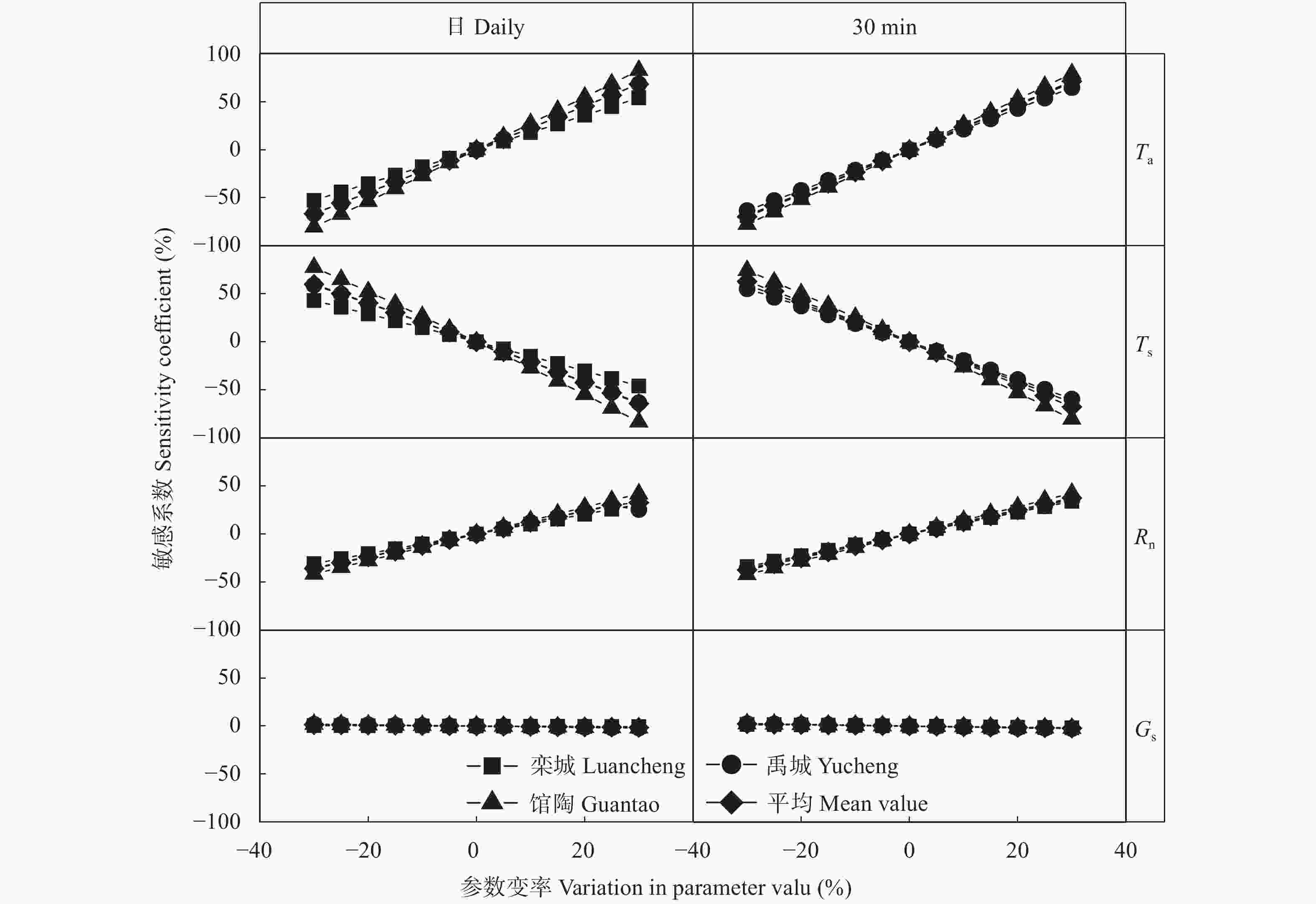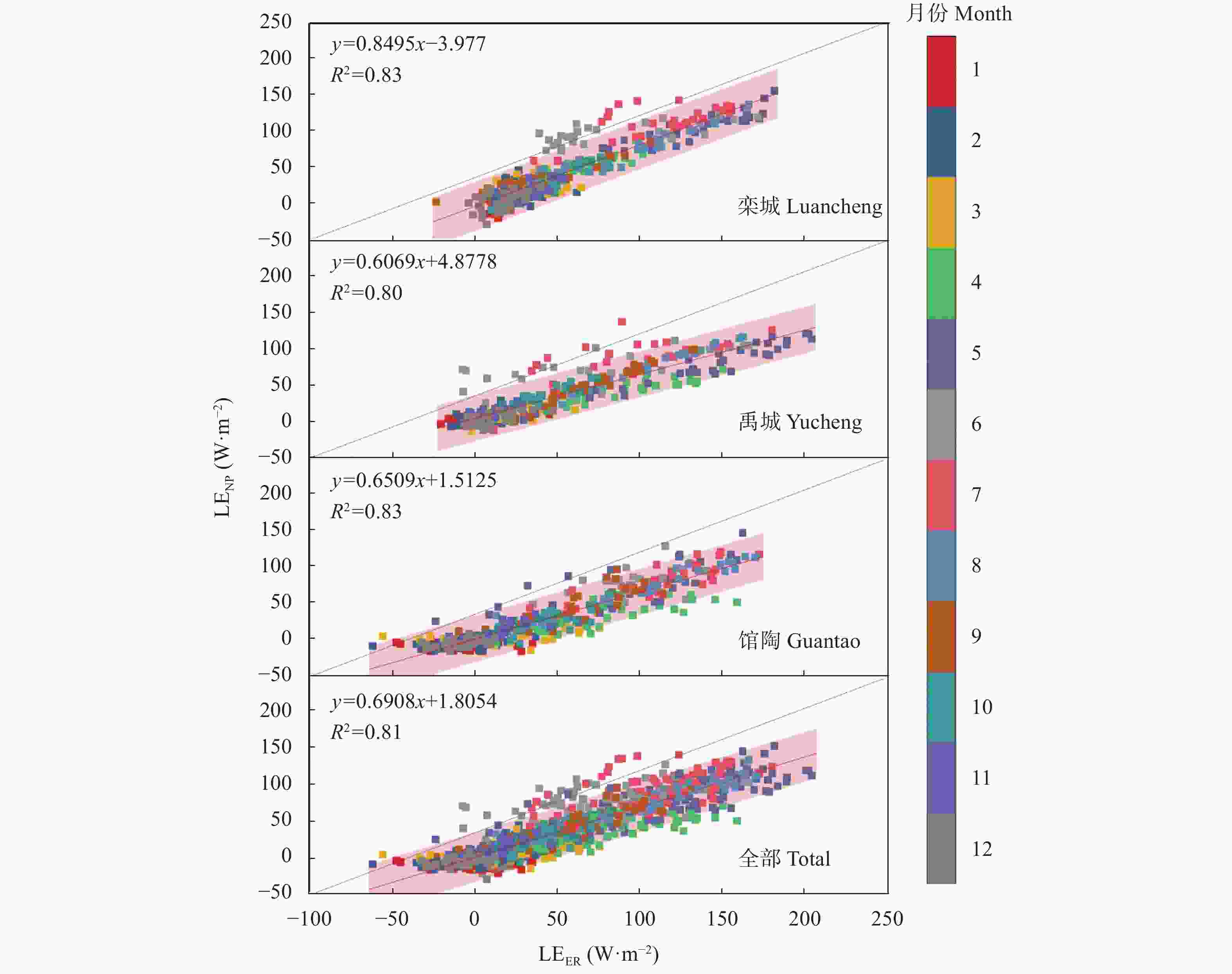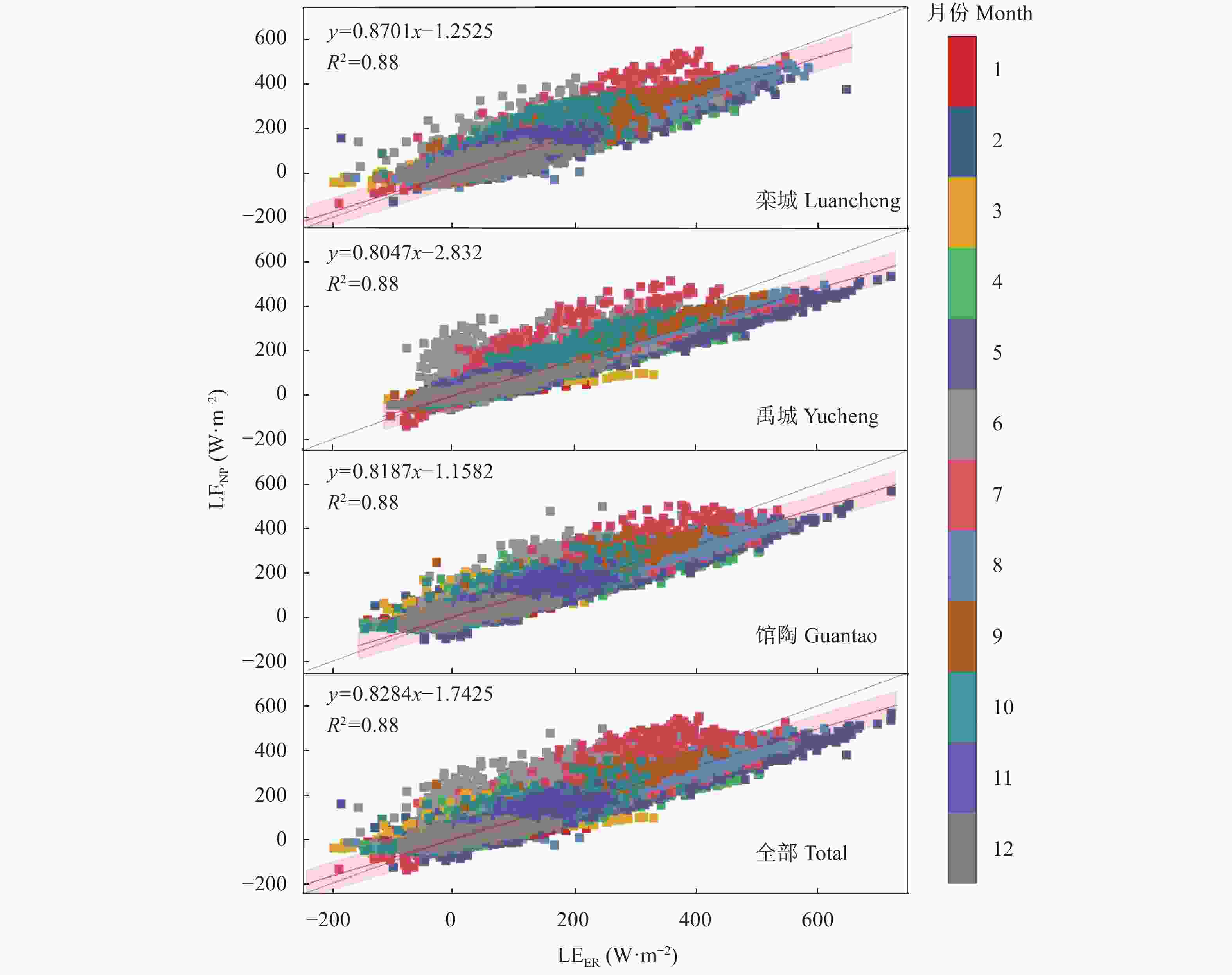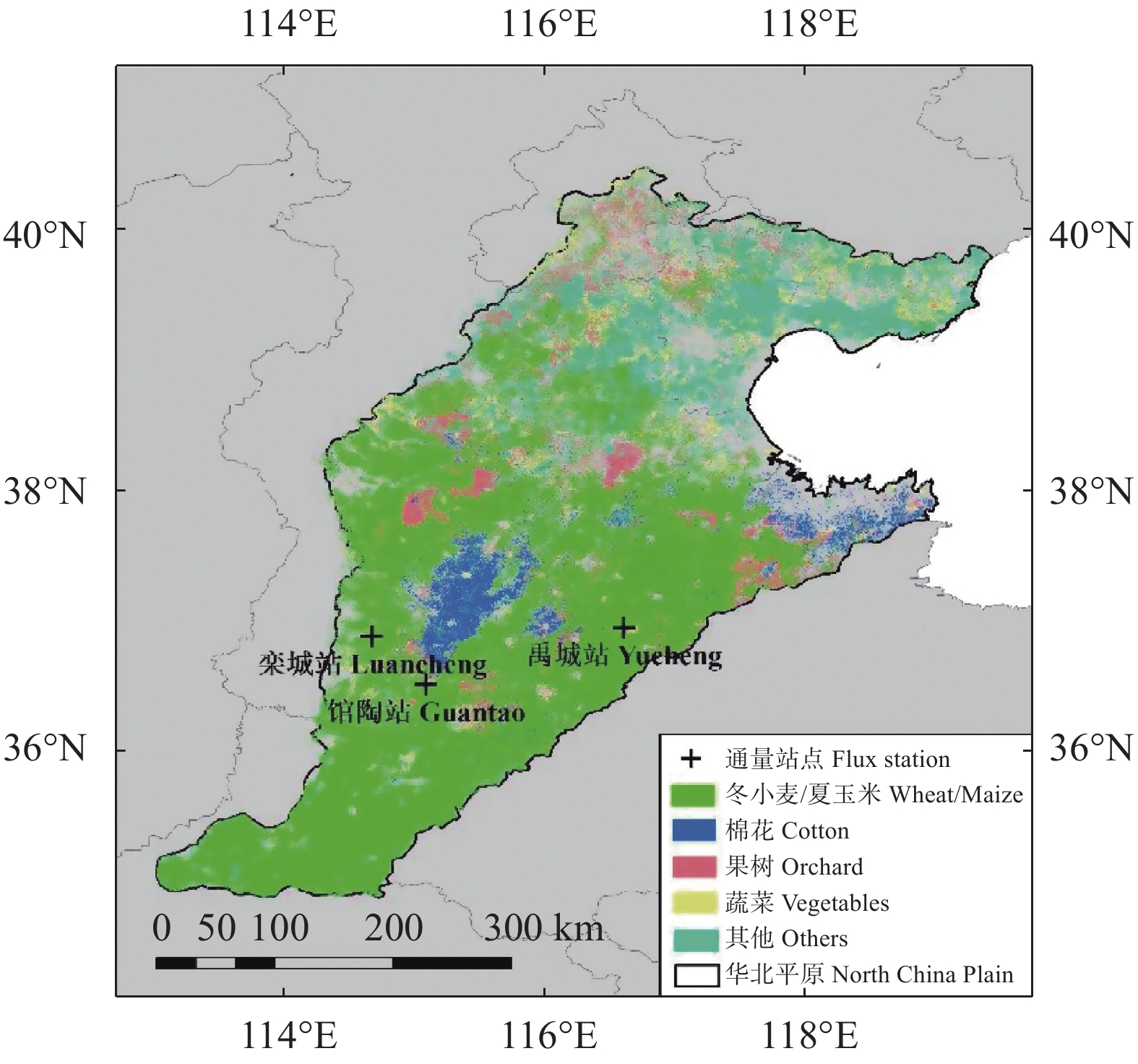Applicability evaluation of the nonparametric approach for estimating evapotranspiration on irrigated farmland in the North China Plain
-
摘要: 蒸散发是水循环和地表能量平衡系统重要的组成部分之一, 是农业、水资源管理和气候变化研究中的基础信息。非参数化蒸散发估算方法避免了复杂的参数化过程, 降低了计算过程的不确定性, 具有广阔的应用前景。本文基于华北灌溉农田中国科学院栾城农业生态系统试验站、中国科学院禹城综合试验站和北京师范大学馆陶试验站3个通量站点的观测数据, 利用非参数化方法估算3个站点30 min和日尺度蒸散发, 利用能量残差闭合修正方法修正后的通量数据为验证参考值, 评价非参数化蒸散发估算方法在华北平原灌溉农田不同季节和不同时间尺度的适用性。结果显示: 1) 非参数化方法在华北灌溉农田不同作物类型、不同时间尺度具有可靠和稳健的表现, 估算结果可以较好地反映季节及日内变化特征, 但总体上低估蒸散发; 对比估算值与参考值, 在日尺度上, 平均偏差为−16.18~−12.88 W∙m−2, 决定系数为0.80~0.83, 均方根误差为22.45~31.06 W∙m−2, Nash-Sutcliffe效率系数为0.66~0.75; 在30 min尺度上, 平均偏差为−13.30~−7.68 W∙m−2, 决定系数均为0.88, 均方根误差为39.22~42.15 W∙m−2, Nash-Sutcliffe效率系数为0.86~0.87。2)非参数化估算方法在水分供应较充足或作物生长茂盛时较严重低估潜热通量, 而在较干燥或作物稀疏时轻度低估或不低估潜热通量。3)该方法对灌溉活动的响应考虑不足, 可能需要在模型结构上进一步改进以提高灌溉农田模拟精度。4)非参数化估算方法在华北灌溉农田中参数敏感性从高到低依次为地表空气温度、地表温度、地表净辐射和土壤热通量, 其中可忽略土壤热通量的影响。该研究不仅为非参数化蒸散发估算方法改进提供参考, 而且有助于加深对蒸散发理论的认识。Abstract: Evapotranspiration (ET), generated by the evaporation of water from a natural surface into the atmosphere, is an important component of the water cycle and surface energy balance system, which is a fundamental information for agriculture, water resource management, and climate change research. In recent decades, the estimation of ET or latent energy (LE, which is the amount of heat required for ET) has remained one of the most challenging problems for researchers. A nonparametric approach for estimating ET may avoid the complex parameterization process and reduce the calculation uncertainties; therefore, it has broad application prospects. However, a more detailed applicability evaluation of the nonparametric approach in different regions or ecosystems is needed, as most of the current studies on the application of this approach focus on arid basins, with few applicability analysis reports focusing on irrigated farmland in sub-humid areas. In this study, the eddy covariance data modified by the energy residual closed correction method in three irrigated farmland stations (Luancheng Agroecosystem Experimental Station, Chinese Academy of Sciences; Yucheng Comprehensive Experimental Station, Chinese Academy of Sciences; and Guantao Experimental Station, Beijing Normal University) in the North China Plain were used as references, and the applicability of the nonparametric approach for estimating LE on irrigated farmland at different time scales (daily scale and 30 min scale) and seasons in the three stations was evaluated. The results showed that the nonparametric approach had reliable and robust performance for different crop types and time scales on irrigated farmland in the North China Plain. The estimated LE could ideally reflect seasonal and intraday variations, but these values were generally underestimated. Furthermore, the bias, coefficient of determination, root mean square error, and Nash-Sutcliffe coefficient at the daily (and 30 min) scale were −16.18 to −12.88 W∙m−2 (−13.30 to −7.68 W∙m−2), 0.80 to 0.83 (0.88), 22.45 to 31.06 W∙m−2 (39.22 to 42.15 W∙m−2), and 0.66 to 0.75 (0.86 to 0.87), respectively. The nonparametric approach significantly underestimated the latent heat flux when the water supply was sufficient or when crops were growing vigorously; moreover, this approach slightly or not underestimated the latent heat flux when the water supply was insufficient or when crops were sparse. In addition, the response of the nonparametric approach to irrigation activities was not considered sufficiently, and further improvement to the model structure may be required to improve the simulation accuracy of irrigated farmland. Finally, the parameter sensitivity of the nonparametric approach in irrigated farmland in the North China Plain, from high to low, was air temperature, surface temperature, net radiation, and soil heat flux, but the influence of soil heat flux can be ignored. Ultimately, this study not only provides a reference for the improvement of the nonparametric ET estimation approach but also helps further the understanding of ET fundamental theory.
-
图 2 日尺度和30 min尺度上3个站点通量站点的能量平衡特征
LE、H、Rn和Gs分布为潜热通量、感热通量、净辐射和土壤热通量; LE+H表示热通量之和; Rn−Gs表示可利用能量。LE, H, Rn and Gs are latent heat flux, sensible heat flux, net radiation and soil heat flux, respectively. LE+H represents the sum of heat fluxes; Rn−Gs represents the available energy.
Figure 2. Energy balance characteristics of flux stations at daily scale and 30 min scale in the three stations
图 3 日尺度上3个站点的潜热通量(LE)年内变化过程及估算结果对比
DOY为年积日。LEER和LENP分别代表利用能量残差法修正后的潜热通量和NP估算得到的潜热通量。箱体图右侧数据从上到下依次为3个站点的LEER和LENP的平均值和中位数。DOY is days of year. LEER and LENP represent the latent heat flux corrected by energy residual method and estimated by the nonparametric approach, respectively. The data on the right side of the box plot from top to bottom are the mean and median of LEER and LENP in the three stations, respectively.
Figure 3. Comparison of latent heat flux (LE) between estimation and observation at daily scale in the three stations
图 4 30 min尺度上3个站点的潜热通量日内变化过程及估算结果对比(9月1—15日)
DOY为年积日。Bias、RE、R2、RMSE和NSE分别为平均偏差、相对误差、决定系数、均方根误差和Nash-Sutcliffe效率系数。DOY is days of year. Bias, RE, R2, RMSE and NSE are mean deviation, relative error, determination coefficient, root mean square error and Nash-Sutcliffe efficiency coefficient, respectively.
Figure 4. Comparison of latent heat flux between estimation and observation at 30 min scale (from September 1st to 15th) in the three stations
图 5 日尺度和30 min尺度3个站点的蒸散发估算精度在各季节上的评价
Bias、RE、R2、RMSE和NSE分别为平均偏差、相对误差、决定系数、均方根误差和Nash-Sutcliffe效率系数。Bias, RE, R2, RMSE and NSE are mean deviation, relative error, determination coefficient, root mean square error and Nash-Sutcliffe efficiency coefficient, respectively.
Figure 5. Accuracy evaluation of evapotranspiration estimates at daily scale and 30 min scale in the three stations
图 7 日尺度上3个站点的潜热通量(LE)估算结果与观测结果的比较
LEER和LENP分别代表利用能量残差法修正后的潜热通量和NP估算得到的潜热通量。黑色实线为1∶1线; 红色实线为线性拟合线; 红色带为95%预测带。LEER and LENP represent the latent heat flux corrected by energy residual method and estimated by the nonparametric approach, respectively. The solid black line is 1∶1 line; the solid red line is the linear fitting line; the red band is the 95% prediction band.
Figure 7. Comparison of latent heat flux (LE) between estimation and observation at daily scale in the three stations
图 8 30 min尺度上3个站点的潜热通量(LE)估算结果与观测结果的比较
LEER和LENP分别代表利用能量残差法修正后的潜热通量和NP估算得到的潜热通量。黑色实线为1∶1线; 红色实线为线性拟合线; 红色带为95%预测带。LEER and LENP represent the latent heat flux corrected by energy residual method and estimated by the nonparametric approach, respectively. The solid black line is 1∶1 line; the solid red line is the linear fitting line; the red band is the 95% prediction band.
Figure 8. Comparison of latent heat flux (LE) between estimation and observation at 30 min scale in the three stations
表 1 3个通量站点能量通量和环境参数平均值
Table 1. Average of energy fluxes and environment parameters at the three stations
参数 Parameter 栾城 Luancheng 禹城 Yucheng 馆陶 Guantao 地表净辐射 Net radiation (Rn, W∙m−2) 72.47 65.04 65.82 土壤热通量 Soil heat flux (Gs, W∙m−2) 0.38 2.21 1.82 地表空气温度 Air temperature (Ta, K) 285.45 286.09 286.7 地表温度 Surface temperature (Ts, K) 285.57 286.9 288.79 大气压 Air pressure (kP) 100.65 101.31 101.04 降水量 Precipitation (mm) 330.1 445.4 577.9 LEER (W∙m−2) 59.16 53.58 47.55 LENP (W∙m−2) 46.28 37.40 32.53 LEER和LENP分别代表利用能量残差法修正后的潜热通量和NP估算得到的潜热通量。LEER and LENP represent the latent heat flux corrected by energy residual method and estimated by the nonparametric approach, respectively. 表 2 日尺度和30 min尺度3个站点的蒸散发估算精度评价
Table 2. Accuracy evaluation of evapotranspiration estimates at daily scale and 30 min scale in the three stations
评价指标
Evaluation index栾城 Luancheng 禹城 Yucheng 馆陶 Guantao 全部 Total 日尺度 Daily 30 min 日尺度 Daily 30 min 日尺度 Daily 30 min 日尺度 Daily 30 min Bias (W∙m−2) −12.88 −7.68 −16.18 −13.30 −15.12 −9.70 −14.73 −10.34 RE (%) 21.8 17.7 30.2 24.8 31.7 20.6 27.5 21.5 R2 0.83 0.88 0.80 0.88 0.83 0.88 0.81 0.88 RMSE (W∙m−2) 22.45 39.22 31.06 42.15 29.00 39.52 27.75 40.37 NSE 0.75 0.87 0.66 0.86 0.71 0.87 0.71 0.87 Bias、RE、R2、RMSE和NSE分别为平均偏差、相对误差、决定系数、均方根误差和Nash-Sutcliffe效率系数。Bias, RE, R2, RMSE and NSE are mean deviation, relative error, determination coefficient, root mean square error and Nash-Sutcliffe efficiency coefficient, respectively. 表 3 日尺度上3个站点的不同修正方法的潜热通量对模拟结果的精度评价
Table 3. Accuracy evaluation of simulation results by latent heat flux of different correction methods at daily scale in the three stations
评价指标
Evaluation index栾城 Luancheng 禹城 Yucheng 馆陶 Guantao 全部 Total LE0 LEBR LEER LE0 LEBR LEER LE0 LEBR LEER LE0 LEBR LEER Bias (W∙m−2) −9.52 −11.06 −12.88 −20.21 −16.92 −16.18 −11.56 −16.61 −15.12 −13.76 −14.86 −14.73 RE (%) 17.1 19.3 21.8 35.1 31.2 30.2 26.2 33.8 31.7 26.1 28.1 27.9 R2 0.61 0.82 0.83 0.73 0.80 0.80 0.37 0.78 0.83 0.57 0.80 0.82 RMSE (W·m−2) 30.17 21.86 22.45 33.21 31.02 31.06 36.84 27.52 29.00 33.41 26.80 27.50 NSE 0.54 0.76 0.75 0.54 0.66 0.66 0.17 0.65 0.71 0.42 0.69 0.71 Bias、RE、 R2、RMSE和NSE分别为平均偏差、相对误差、决定系数、均方根误差和Nash-Sutcliffe效率系数。LE0为未修正的潜热通量, LEER和LEBR分别代表利用能量残差法和Bowen比闭合修正法修正后的潜热通量。Bias, RE, R2, RMSE and NSE are mean deviation, relative error, determination coefficient, root mean square error and Nash-Sutcliffe efficiency coefficient, respectively. LE0 is uncorrected latent heat flux, LEER and LEBR represent the latent heat flux corrected by energy residual method and Bowen ratio closed correction method, respectively. -
[1] HAN S J, TIAN F Q. Integration of Penman approach with complementary principle for evaporation research[J]. Hydrological Processes, 2018, 32(19): 3051−3058 doi: 10.1002/hyp.13171 [2] FISHER J B, MELTON F, MIDDLETON E, et al. The future of evapotranspiration: Global requirements for ecosystem functioning, carbon and climate feedbacks, agricultural management, and water resources[J]. Water Resources Research, 2017, 53(4): 2618−2626 doi: 10.1002/2016WR020175 [3] JUNG M, REICHSTEIN M, CIAIS P, et al. Recent decline in the global land evapotranspiration trend due to limited moisture supply[J]. Nature, 2010, 467(7318): 951−954 doi: 10.1038/nature09396 [4] OKI T, KANAE S. Global hydrological cycles and world water resources[J]. Science, 2006, 313(5790): 1068−1072 doi: 10.1126/science.1128845 [5] GLENN E P, HUETE A R, NAGLER P L, et al. Integrating remote sensing and ground methods to estimate evapotranspiration[J]. Critical Reviews in Plant Sciences, 2007, 26(3): 139−168 doi: 10.1080/07352680701402503 [6] TRENBERTH K E, FASULLO J T, KIEHL J. Earth’s global energy budget[J]. Bulletin of the American Meteorological Society, 2009, 90(3): 311−324 doi: 10.1175/2008BAMS2634.1 [7] WANG K C, DICKINSON R E. A review of global terrestrial evapotranspiration: Observation, modeling, climatology, and climatic variability[J]. Reviews of Geophysics, 2012, 50(2): RG2005 doi: 10.1029/2011rg000373 [8] MA N, SZILAGYI J. The CR of evaporation: a calibration-free diagnostic and benchmarking tool for large-scale terrestrial evapotranspiration modeling[J]. Water Resources Research, 2019, 55(8): 7246−7274 doi: 10.1029/2019WR024867 [9] PENMAN H L. Natural evaporation from open water, bare soil and grass[J]. Proceedings of the Royal Society of London Series A— Mathematical and Physical Sciences, 1948, 193(1032): 120−145 [10] MONTEITH J L. Evaporation and environment[J]. Symposia of the Society for Experimental Biology, 1965, 19: 205−234 [11] WANG K C, LIANG S L. An improved method for estimating global evapotranspiration based on satellite determination of surface net radiation, vegetation index, temperature, and soil moisture[J]. Journal of Hydrometeorology, 2008, 9(4): 712−727 doi: 10.1175/2007JHM911.1 [12] BASTIAANSSEN W G M, MENENTI M, FEDDES R A, et al. A remote sensing surface energy balance algorithm for land (SEBAL). 1. Formulation[J]. Journal of Hydrology, 1998, 212/213: 198−212 doi: 10.1016/S0022-1694(98)00253-4 [13] SU Z. The Surface Energy Balance System (SEBS) for estimation of turbulent heat fluxes[J]. Hydrology and Earth System Sciences, 2002, 6(1): 85−100 doi: 10.5194/hess-6-85-2002 [14] ROERINK G J, SU Z, MENENTI M. S-SEBI: a simple remote sensing algorithm to estimate the surface energy balance[J]. Physics and Chemistry of the Earth, Part B: Hydrology, Oceans and Atmosphere, 2000, 25(2): 147−157 doi: 10.1016/S1464-1909(99)00128-8 [15] OLTCHEV A, CONSTANTIN J, GRAVENHORST G, et al. Application of a six-layer SVAT model for simulation of evapotranspiration and water uptake in a spruce forest[J]. Physics and Chemistry of the Earth, 1996, 21(3): 195−199 doi: 10.1016/S0079-1946(97)85584-X [16] BRUTSAERT W. A generalized complementary principle with physical constraints for land-surface evaporation[J]. Water Resources Research, 2015, 51(10): 8087−8093 doi: 10.1002/2015WR017720 [17] DE GARCÍA-VALDECASAS OJEDA M, ROSA-CÁNOVAS J J, ROMERO-JIMÉNEZ E, et al. The role of the surface evapotranspiration in regional climate modelling: Evaluation and near-term future changes[J]. Atmospheric Research, 2020, 237: 104867 doi: 10.1016/j.atmosres.2020.104867 [18] ALLEN R G, PEREIRA L S, RAES D, et al. Crop Evapotranspiration Guidelines for Computing Crop Water Requirements. FAO Irrigation and Drainage Paper 56[R]. Rome: FAO, 1998: 100−109 [19] FU Q, LIN L, HUANG J P, et al. Changes in terrestrial aridity for the period 850 –2080 from the Community Earth System Model[J]. Journal of Geophysical Research: Atmospheres, 2016, 121(6): 2857−2873 doi: 10.1002/2015JD024075 [20] SHUTTLEWORTH W J, WALLACE J S. Evaporation from sparse crops-an energy combination theory[J]. Quarterly Journal of the Royal Meteorological Society, 1985, 111(469): 839−855 doi: 10.1002/qj.49711146910 [21] LIU Y B, HIYAMA T, YASUNARI T, et al. A nonparametric approach to estimating terrestrial evaporation: Validation in eddy covariance sites[J]. Agricultural and Forest Meteorology, 2012, 157: 49−59 doi: 10.1016/j.agrformet.2012.01.012 [22] RAHMAN M M, ZHANG W C. Review on estimation methods of the earth’s surface energy balance components from ground and satellite measurements[J]. Journal of Earth System Science, 2019, 128(4): 1−22 [23] 王宁, 贾立, 李占胜, 等. 非参数化蒸散发估算方法在黑河流域的适用性分析[J]. 高原气象, 2016, 35(1): 118−128WANG N, JIA L, LI Z S, et al. Applicability analysis of nonparametric evapotranspiration approach over Heihe River Basin[J]. Plateau Meteorology, 2016, 35(1): 118−128 [24] PAN X, LIU Y B, FAN X W. Satellite retrieval of surface evapotranspiration with nonparametric approach: accuracy assessment over a semiarid region[J]. Advances in Meteorology, 2016, 1584316. http://dx.doi.org/10.1155/2016/1584316 [25] PAN X, LIU Y B, GAN G J, et al. Estimation of evapotranspiration using a nonparametric approach under all sky: accuracy evaluation and error analysis[J]. IEEE Journal of Selected Topics in Applied Earth Observations and Remote Sensing, 2017, 10(6): 2528−2539 doi: 10.1109/JSTARS.2017.2707586 [26] PAN X, YOU C S, LIU Y B, et al. Evaluation of satellite-retrieved evapotranspiration based on a nonparametric approach over an arid region[J]. International Journal of Remote Sensing, 2020, 41(19): 7605−7623 doi: 10.1080/01431161.2020.1763505 [27] YANG Y M, SU H B, QI J W. A critical evaluation of the nonparametric approach to estimate terrestrial evaporation[J]. Advances in Meteorology, 2016, 5343718. http://dx.doi.org/10.1155/2016/5343718 [28] 沈彦俊, 刘昌明. 华北平原典型井灌区农田水循环过程研究回顾[J]. 中国生态农业学报, 2011, 19(5): 1004−1010SHEN Y J, LIU C M. Agro-ecosystems water cycles of the typical irrigated farmland in the North China Plain[J]. Chinese Journal of Eco-Agriculture, 2011, 19(5): 1004−1010 [29] LEI H M, YANG D W, YANG H B, et al. Simulated impacts of irrigation on evapotranspiration in a strongly exploited region: a case study of the Haihe River Basin, China[J]. Hydrological Processes, 2015, 29(12): 2704−2719 doi: 10.1002/hyp.10402 [30] ZHANG Y C, QI Y Q, SHEN Y J, et al. Mapping the agricultural land use of the North China Plain in 2002 and 2012[J]. Journal of Geographical Sciences, 2019, 29(6): 909−921 doi: 10.1007/s11442-019-1636-8 [31] FALGE E, BALDOCCHI D, OLSON R, et al. Gap filling strategies for defensible annual sums of net ecosystem exchange[J]. Agricultural and Forest Meteorology, 2001, 107(1): 43−69 doi: 10.1016/S0168-1923(00)00225-2 [32] GU F X, ZHANG Y D, HUANG M, et al. Climate-driven uncertainties in modeling terrestrial ecosystem net primary productivity in China[J]. Agricultural and Forest Meteorology, 2017, 246: 123−132 doi: 10.1016/j.agrformet.2017.06.011 [33] TWINE T E, KUSTAS W P, NORMAN J M, et al. Correcting eddy-covariance flux underestimates over a grassland[J]. Agricultural and Forest Meteorology, 2000, 103(3): 279−300 doi: 10.1016/S0168-1923(00)00123-4 [34] AMIRO B. Measuring boreal forest evapotranspiration using the energy balance residual[J]. Journal of Hydrology, 2009, 366(1/2/3/4): 112−118 [35] FOKEN T. The energy balance closure problem: an overview[J]. Ecological Applications, 2008, 18(6): 1351−1367 doi: 10.1890/06-0922.1 [36] ERSHADI A, MCCABE M F, EVANS J P, et al. Multi-site evaluation of terrestrial evaporation models using FLUXNET data[J]. Agricultural and Forest Meteorology, 2014, 187: 46−61 doi: 10.1016/j.agrformet.2013.11.008 [37] 于贵瑞, 张雷明, 孙晓敏. 中国陆地生态系统通量观测研究网络(ChinaFLUX)的主要进展及发展展望[J]. 地理科学进展, 2014, 33(7): 903−917 doi: 10.11820/dlkxjz.2014.07.005YU G R, ZHANG L M, SUN X M. Progresses and prospects of Chinese terrestrial ecosystem flux observation and research network (ChinaFLUX)[J]. Progress in Geography, 2014, 33(7): 903−917 doi: 10.11820/dlkxjz.2014.07.005 [38] MAHRT L. Computing turbulent fluxes near the surface: Needed improvements[J]. Agricultural and Forest Meteorology, 2010, 150(4): 501−509 doi: 10.1016/j.agrformet.2010.01.015 [39] JIA Z Z, LIU S M, XU Z W, et al. Validation of remotely sensed evapotranspiration over the Hai River Basin, China[J]. Journal of Geophysical Research: Atmospheres, 2012, 117(D13): D13113 doi: 10.1029/2011jd017037 [40] WILSON K, GOLDSTEIN A, FALGE E, et al. Energy balance closure at FLUXNET sites[J]. Agricultural and Forest Meteorology, 2002, 113(1/2/3/4): 223−243 [41] 岳平, 张强, 杨金虎, 等. 黄土高原半干旱草地地表能量通量及闭合率[J]. 生态学报, 2011, 31(22): 6866−6876YUE P, ZHANG Q, YANG J H, et al. Surface heat flux and energy budget for semi-arid grassland on the Loess Plateau[J]. Acta Ecologica Sinica, 2011, 31(22): 6866−6876 [42] 徐自为, 刘绍民, 徐同仁, 等. 不同土壤热通量测算方法的比较及其对地表能量平衡闭合影响的研究[J]. 地球科学进展, 2013, 28(8): 875−889 doi: 10.11867/j.issn.1001-8166.2013.08.0875XU Z W, LIU S M, XU T R, et al. The observation and calculation method of soil heat flux and its impact on the energy balance closure[J]. Advances in Earth Science, 2013, 28(8): 875−889 doi: 10.11867/j.issn.1001-8166.2013.08.0875 [43] MAUDER M, ONCLEY S P, VOGT R, et al. The energy balance experiment EBEX-2000. Part Ⅱ: Intercomparison of eddy-covariance sensors and post-field data processing methods[J]. Boundary-Layer Meteorology, 2007, 123(1): 29−54 doi: 10.1007/s10546-006-9139-4 [44] XU Z W, LIU S M, LI X, et al. Intercomparison of surface energy flux measurement systems used during the HiWATER-MUSOEXE[J]. Journal of Geophysical Research: Atmospheres, 2013, 118(23): 13140−13157 doi: 10.1002/2013JD020260 [45] KIDSTON J, BRÜMMER C, BLACK T A, et al. Energy balance closure using eddy covariance above two different land surfaces and implications for CO2 flux measurements[J]. Boundary-Layer Meteorology, 2010, 136(2): 193−218 doi: 10.1007/s10546-010-9507-y [46] PAN X, LIU Y B, FAN X W, et al. Two energy balance closure approaches: applications and comparisons over an oasis-desert ecotone[J]. Journal of Arid Land, 2017, 9(1): 51−64 doi: 10.1007/s40333-016-0063-2 [47] YAO Y J, LIANG S L, YU J, et al. A simple temperature domain two-source model for estimating agricultural field surface energy fluxes from Landsat images[J]. Journal of Geophysical Research: Atmospheres, 2017, 122(10): 5211−5236 doi: 10.1002/2016JD026370 [48] BAIK J, CHOI M. Evaluation of geostationary satellite (COMS) based Priestley-Taylor evapotranspiration[J]. Agricultural Water Management, 2015, 159: 77−91 doi: 10.1016/j.agwat.2015.05.017 -





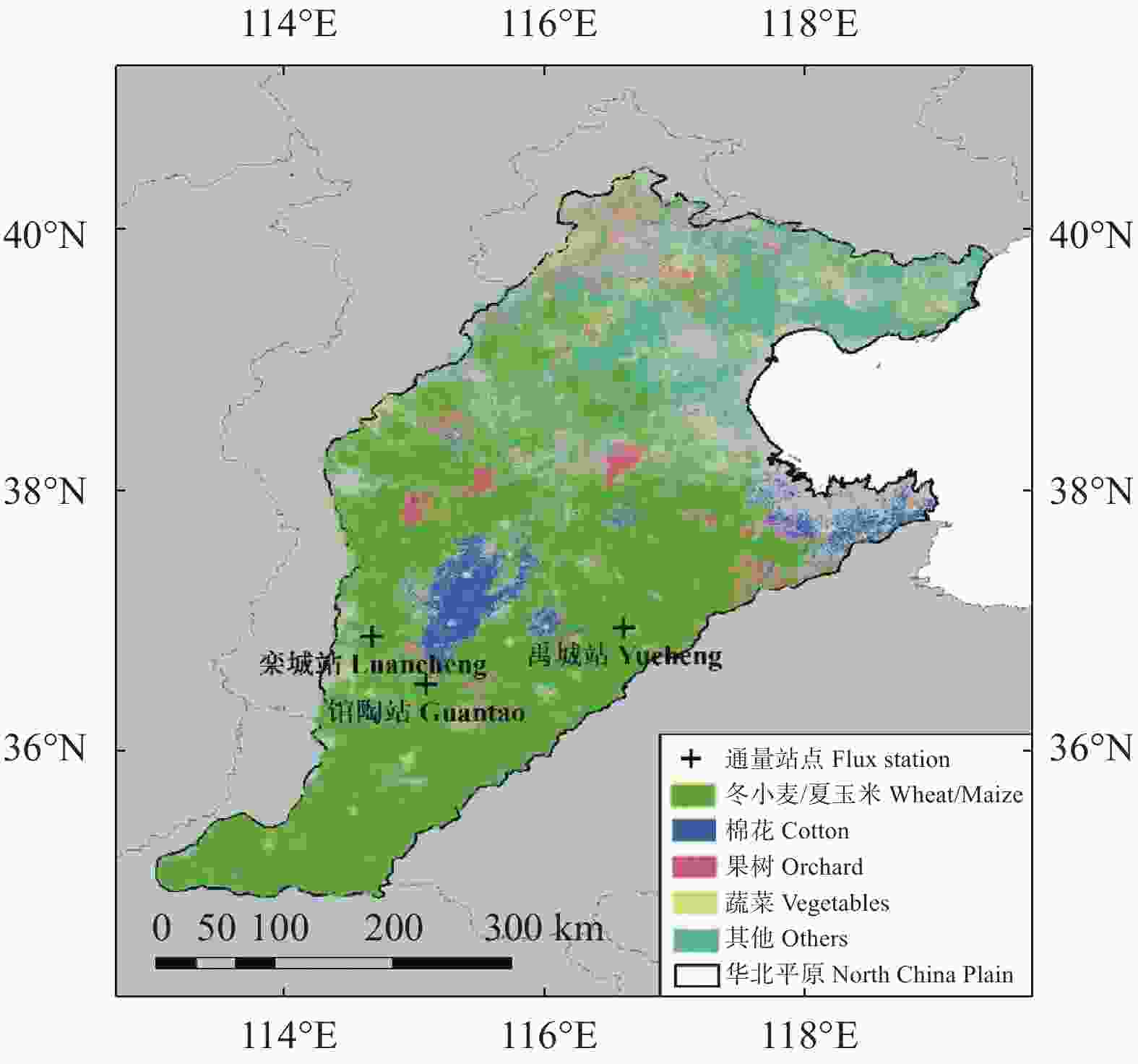
 下载:
下载:
